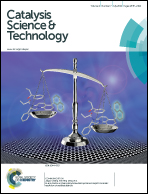Rhodium catalyzed hydroformylation of nerolidol
Abstract
The rhodium-catalyzed hydroformylation of nerolidol, a biorenewable substrate with strong therapeutic potential available from various essential oils, was studied in toluene and ethanol solutions in the presence of PPh3 or P(O-o-tBuPh)3 ligands. In toluene, the reaction gave with high chemo- and stereoselectivity a cyclic hemiacetal, which formally arises from the intramolecular cyclization of the primarily formed hydroxy aldehyde. In ethanol, hydroformylation gave a corresponding cyclic acetal in excellent yields even without additional acid co-catalysts. In the absence of phosphorous ligands, nerolidol was resistant to hydroformylation probably due to binding with rhodium through both the double bond and the hydroxyl group to form stable chelates. The P(O-o-tBuPh)3 ligand exerted a remarkable effect on the substrate reactivity accelerating the reaction by five to ten times as compared to the system with PPh3. All isolated products have a pleasant sweet floral and woody scent and can be useful as components of synthetic fragrances.


 Please wait while we load your content...
Please wait while we load your content...